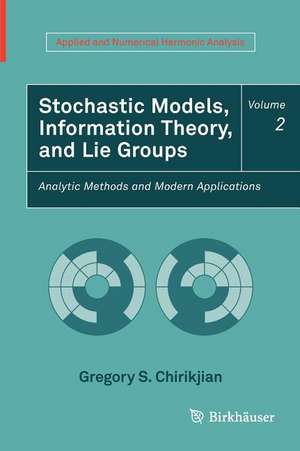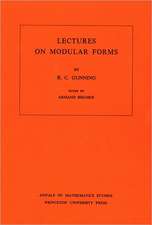Stochastic Models, Information Theory, and Lie Groups, Volume 2: Analytic Methods and Modern Applications: Applied and Numerical Harmonic Analysis
Autor Gregory S. Chirikjianen Limba Engleză Hardback – 15 noi 2011
Volume 2 builds on the fundamentals presented in Volume 1, delving deeper into relationships among stochastic geometry, geometric aspects of the theory of communications and coding, multivariate statistical analysis, and error propagation on Lie groups. Extensive exercises, motivating examples, and real-world applications make the work suitable as a textbook for use in courses that emphasize applied stochastic processes or differential geometry.
Stochastic Models, Information Theory, and Lie Groups will be of interest to advanced undergraduate and graduate students, researchers, and practitioners working in applied mathematics, the physical sciences, and engineering.
Din seria Applied and Numerical Harmonic Analysis
-
 Preț: 399.29 lei
Preț: 399.29 lei - 20%
 Preț: 673.02 lei
Preț: 673.02 lei - 17%
 Preț: 431.76 lei
Preț: 431.76 lei - 19%
 Preț: 443.08 lei
Preț: 443.08 lei -
 Preț: 412.57 lei
Preț: 412.57 lei - 15%
 Preț: 550.04 lei
Preț: 550.04 lei - 15%
 Preț: 653.98 lei
Preț: 653.98 lei - 18%
 Preț: 1014.28 lei
Preț: 1014.28 lei - 15%
 Preț: 647.92 lei
Preț: 647.92 lei -
 Preț: 413.37 lei
Preț: 413.37 lei - 15%
 Preț: 648.74 lei
Preț: 648.74 lei - 15%
 Preț: 654.77 lei
Preț: 654.77 lei - 15%
 Preț: 636.80 lei
Preț: 636.80 lei - 15%
 Preț: 532.89 lei
Preț: 532.89 lei - 15%
 Preț: 646.62 lei
Preț: 646.62 lei - 15%
 Preț: 653.98 lei
Preț: 653.98 lei -
 Preț: 397.38 lei
Preț: 397.38 lei - 15%
 Preț: 656.43 lei
Preț: 656.43 lei - 18%
 Preț: 957.13 lei
Preț: 957.13 lei - 24%
 Preț: 829.74 lei
Preț: 829.74 lei -
 Preț: 398.35 lei
Preț: 398.35 lei - 20%
 Preț: 569.86 lei
Preț: 569.86 lei -
 Preț: 392.21 lei
Preț: 392.21 lei - 18%
 Preț: 1121.76 lei
Preț: 1121.76 lei - 18%
 Preț: 1001.32 lei
Preț: 1001.32 lei -
 Preț: 387.75 lei
Preț: 387.75 lei - 15%
 Preț: 653.98 lei
Preț: 653.98 lei - 20%
 Preț: 567.32 lei
Preț: 567.32 lei - 20%
 Preț: 573.77 lei
Preț: 573.77 lei -
 Preț: 406.80 lei
Preț: 406.80 lei -
 Preț: 387.38 lei
Preț: 387.38 lei - 5%
 Preț: 1168.71 lei
Preț: 1168.71 lei -
 Preț: 400.85 lei
Preț: 400.85 lei -
 Preț: 398.15 lei
Preț: 398.15 lei - 15%
 Preț: 644.49 lei
Preț: 644.49 lei - 19%
 Preț: 575.84 lei
Preț: 575.84 lei - 15%
 Preț: 703.71 lei
Preț: 703.71 lei - 20%
 Preț: 334.71 lei
Preț: 334.71 lei - 15%
 Preț: 525.54 lei
Preț: 525.54 lei -
 Preț: 405.06 lei
Preț: 405.06 lei - 15%
 Preț: 536.96 lei
Preț: 536.96 lei
Preț: 661.97 lei
Preț vechi: 778.80 lei
-15% Nou
Puncte Express: 993
Preț estimativ în valută:
126.68€ • 131.77$ • 104.58£
126.68€ • 131.77$ • 104.58£
Carte tipărită la comandă
Livrare economică 15-29 aprilie
Preluare comenzi: 021 569.72.76
Specificații
ISBN-13: 9780817649432
ISBN-10: 0817649433
Pagini: 435
Ilustrații: XXVII, 435 p.
Dimensiuni: 178 x 254 x 25 mm
Greutate: 1.02 kg
Ediția:1st Edition.
Editura: Birkhäuser Boston
Colecția Birkhäuser
Seria Applied and Numerical Harmonic Analysis
Locul publicării:Boston, MA, United States
ISBN-10: 0817649433
Pagini: 435
Ilustrații: XXVII, 435 p.
Dimensiuni: 178 x 254 x 25 mm
Greutate: 1.02 kg
Ediția:1st Edition.
Editura: Birkhäuser Boston
Colecția Birkhäuser
Seria Applied and Numerical Harmonic Analysis
Locul publicării:Boston, MA, United States
Public țintă
GraduateCuprins
Lie Groups I: Introduction and Examples.- Lie Groups II: Differential Geometric Properties.- Lie Groups III: Integration, Convolution, and Fourier Analysis.- Variational Calculus on Lie Groups.- Statistical Mechanics and Ergodic Theory.- Parts Entropy and the Principal Kinematic Formula.- Estimation and Multivariate Analysis in R^n.- Information, Communication, and Group Therapy.- Algebraic and Geometric Coding Theory.- Information Theory on Lie Groups.- Stochastic Processes on Lie Groups.- Locomotion and Perception as Communication over Principal Fiber Bundles; and A Survey of Additional Applications.
Textul de pe ultima copertă
The subjects of stochastic processes, information theory, and Lie groups are usually treated separately from each other. This unique two-volume set presents these topics in a unified setting, thereby building bridges between fields that are rarely studied by the same people. Unlike the many excellent formal treatments available for each of these subjects individually, the emphasis in both of these volumes is on the use of stochastic, geometric, and group-theoretic concepts in the modeling of physical phenomena.
Volume 1 establishes the geometric and statistical foundations required to understand the fundamentals of continuous-time stochastic processes, differential geometry, and the probabilistic foundations of information theory. Volume 2 delves deeper into relationships between these topics, including stochastic geometry, geometric aspects of the theory of communications and coding, multivariate statistical analysis, and error propagation on Lie groups.
Key features and topics of Volume 2:
* The author reviews the concept of—and functions and integration on—Lie groups with many concrete examples.
* Extensive exercises and motivating examples make the work suitable as a textbook for use in courses that emphasize applied stochastic processes on Lie groups or geometric aspects of probability and statistics.
* Specific application areas are explored, including biomolecular statistical mechanics and information-driven motion in robotics.
* The concrete presentation style makes it easy for readers to obtain numerical solutions for their own problems; the emphasis is on how to calculate quantities rather than how to prove theorems.
* Modern problems at the interface of mechanics, control theory, and communications are handled in a unified framework and multiple directions for future research are explored.
Stochastic Models, Information Theory, and Lie Groups will beof interest to advanced undergraduate and graduate students, researchers, and practitioners working in applied mathematics, the physical sciences, and engineering.
Volume 1 establishes the geometric and statistical foundations required to understand the fundamentals of continuous-time stochastic processes, differential geometry, and the probabilistic foundations of information theory. Volume 2 delves deeper into relationships between these topics, including stochastic geometry, geometric aspects of the theory of communications and coding, multivariate statistical analysis, and error propagation on Lie groups.
Key features and topics of Volume 2:
* The author reviews the concept of—and functions and integration on—Lie groups with many concrete examples.
* Extensive exercises and motivating examples make the work suitable as a textbook for use in courses that emphasize applied stochastic processes on Lie groups or geometric aspects of probability and statistics.
* Specific application areas are explored, including biomolecular statistical mechanics and information-driven motion in robotics.
* The concrete presentation style makes it easy for readers to obtain numerical solutions for their own problems; the emphasis is on how to calculate quantities rather than how to prove theorems.
* Modern problems at the interface of mechanics, control theory, and communications are handled in a unified framework and multiple directions for future research are explored.
Stochastic Models, Information Theory, and Lie Groups will beof interest to advanced undergraduate and graduate students, researchers, and practitioners working in applied mathematics, the physical sciences, and engineering.
Caracteristici
Unique work: the only book to use tools and concepts from several mathematical areas usually treated in separate books—stochastic processes, information theory, and Lie theory—thereby building bridges between topics rarely studied by the same individuals Extensive exercises and numerous examples used to motivate concepts with an emphasis on modeling physical phenomena Concrete presentation makes it easy for readers to obtain numerical solutions for their own problems Applications to a variety of areas, including conformational fluctuations of DNA, infotaxis, statistical mechanics, and biomolecular information theory Suitable as a textbook for advanced undergraduate and graduate courses in applied stochastic processes or differential geometry For a broad audience of advanced undergraduate and graduate students, researchers, and practitioners in applied mathematics, the physical sciences, and engineering Includes supplementary material: sn.pub/extras















